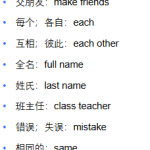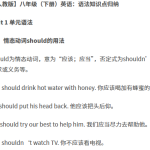2024新英语译林版7上分单元语法讲解(全册 14页)
2024新英语译林版7上分单元语法讲解(全册 14页)
牛津译林版(2024)七年级英语上册分单元语法讲解(全册)Unit 1
动词be的一般现在时
be动词的一般现在时有am、 is、 are三种形式,常用来表示人或事物的性质或状态等,说明主语”是什么”或”怎么样”。动词be要随着主语人称和数的变化而变化。
动词be的一般现在时的基本用法
| 主语 | be动词 | 例句 |
| I(我) | am | I’m in Class Six. 我在六班。 |
| you(你,你们)
we(我们) they(他/她/它们) these(这些) those(那些) 其他复数名词或代词 |
are | Are you Lily? 你是莉莉吗?
Those arent my books. 那些不是我的书。 Her parents are teachers.她的父母是老师。 |
| he(他)
she(她) it(它) this(这个) that(那个) 其他第三人称单数代词或可数名词单数 |
is | He is a worker. 他是一名工人。
This is my bag. Its blue.这是我的包。它是蓝色的。 My sister is cute. 我的妹妹很可爱。 |
动词be的用法口诀
我(I)用am,你(you)用are,is连接他(he)、她(she)、它(it)。单数名词用is,凡是复数全用are。
如果主语是人称代词,在非正式文体中,动词be与前面主语可以缩写。
I am = I’m we/you/they are = we’re/you’re/they’re he/she/it is = he’s/she’s/it’s
动词be的一般现在时的句式转换
1.肯定句变否定句:
在动词be(am,is,are)后加not。
I’m good at dancing.我擅长跳舞。→I’m not good at dancing. 我不擅长跳舞。
He is my classmate.他是我的同班同学。→He isn’t my classmate. 他不是我的同班同学。
Sandy and Millie are over there.桑迪和米莉在那边。→Sandy and Millie aren’t over there.桑迪和米莉不在那边。
在非正式文体中,动词is/are与not可以缩写,如is not=isn’t,are not=aren’t。但am与not不能缩写。
2.陈述句变一般疑问句:
将动词be(am,is,are)提前至句首,并将其首字母大写,句末句点变问号。
句型结构:Be+主语+…?
肯定回答:Yes, 主语(代词)+动词be. 否定回答:No, 主语(代词)+动词be+not.
We are in the same class.我们在同一个班级。→
—Are you in the same class?你们在同一个班级吗?
—Yes,we are./No,we aren’t.是的,我们在(同一个班级)。/不,我们不在(同一个班级)。
My new school is nice. 我的新学校很漂亮。→
—Is your new school nice?你的新学校漂亮吗?
—Yes, it is./No, it isn’t. 是的,它很漂亮。/不,它不漂亮。
含动词be的一般现在时的句型变化
变疑问,往前提,句末问号莫丢弃。 变否定,更容易,be后not莫忘记。
(1) 陈述句的主语若是第一人称I/we,变一般疑问句时,要将主语换成第二人称you。
(2)在肯定答句中,主语和动词be不能缩写。如”Yes, she is.”不可缩略为”Yes, she’s.”。
Unit 2 行为动词的一般现在时
行为动词一般现在时的基本用法
| 用法 | 例句 |
| 表示经常性、习惯性的动作。 | My father gets up at 6:00 every morning.我的父亲每天早上6点起床。 |
| 表示目前的爱好、能力等。 | My mother sings very well.我的母亲歌唱得很好。 |
| 表示不受时限的客观事实。 | The earth goes around the sun.地球绕着太阳转。 |
一般现在时常与always、 often、 usually、 sometimes等频度副词或every day/week/morning、in the morning/afternoon/evening等时间状语连用。
行为动词一般现在时的两种形式
根据主语的人称和数的不同,行为动词的一般现在时有两种形式。
(1)当主语是第一人称、第二人称和第三人称的复数时,行为动词使用其原形。
We have breakfast and supper at home.我们在家吃早饭和晚饭。
You like swimming, right? 你们喜欢游泳,对吗?
My parents read books at weekends.我父母周末读书。
(2)当主语是第三人称单数时,行为动词使用其第三人称单数形式。
He does his homework at home. 他在家里做他的家庭作业。
行为动词一般现在时的第三人称单数形式的构成方法
| 规则 | 示例 |
| 大部分动词后加s | like→likes live→lives |
| 以辅音字母+y结尾的动词,变y为i,再加es | study→studies fly→flies |
| 以ch、sh、ss或x结尾的动词后加es | watch→watches wash→washes dress→dresses fix→fixes |
| 以辅音字母+o结尾的动词后加es | go→goes do→does |
| 特殊变化 | have→has |
含行为动词的一般现在时的句式结构
| 句式 | 句式结构 | 例句 |
| 肯定句 | 主语+动词原形 /动词的第三人称单数形式(+其他). | I like pears.我喜欢梨。
The sun rises in the east.太阳从东方升起。 |
| 否定句 | 主语+don’t/doesn’t+动词原形(+其他). | I don’t like milk.我不喜欢牛奶。
She doesn’t want to go out.她不想出去。 |
| 一般疑问句及其简略回答 | Do/Does+主语+动词原形(+其他)?
肯定回答:Yes, 主语+do/does. 否定回答:No, 主语+don’t/ doesn’t. |
—Do you go to school by bike?你骑自行车去上学吗?
—Yes, I do./No, I don’t.是的,我骑。/不,我不骑。 —Does Millie live in Beijing? Millie住在北京吗? —Yes, she does./No, she doesn’t.是的,她住在北京。/不,她不住在北京。 |
Unit 3
人称代词
人称代词的数和格
| 数 | 单数 | 复数 | ||
| 格 | 主格 | 宾格 | 主格 | 宾格 |
| 第一人称 | I | me | we | us |
| 第二人称 | you | you | you | you |
| 第三人称 | he | him | they | them |
| she | her | |||
| it | it | |||
人称代词的用法
(1)人称代词主格的用法: 人称代词的主格作句子的主语。
I like reading. 我喜欢阅读。 Where are they? 他们在哪儿?
(2)人称代词宾格的用法
①人称代词的宾格作及物动词或介词的宾语。
Let me show you around our school.让我带你们参观我们学校吧。
Please look after her for me. 请替我照顾她。
②在口语中,人称代词作动词be的表语时,通常可用其宾格形式代替主格。
—Who is knocking at the door? 谁在敲门? —It’s me. 是我。
③人称代词单独使用时,一般用宾格而不用主格。
—I’d like to have a cup of coffee.我想喝一杯咖啡。 —Me too. 我也是。
(3)人称代词it的用法
it可指代无生命的事物、天气、时间、性别不明确的动物、植物、婴儿以及未知身份的人。
English is very interesting. It is my favourite subject. 英语很有趣。它是我最喜爱的学科。
Its rainy today.今天有雨。
What a lovely baby it is! 多么可爱的宝宝啊!
—Who is it there? 谁在那边? —It’s Li Lei.是李磊。
人称代词的排序
人称代词单数的排序为:you, he/she, I(第二、三、一人称);人称代词复数的排序为:we, you, they(第一、二、三人称)。
You, he and I are all good at English.你、我和他都擅长英语。
We, you and they are all Chinese.你们、我们和他们都是中国人。
在承认错误、承担责任时,应把I或we(第一人称)放在首位。
I and he are wrong. 我和他错了。
Unit 4
表示时间的介词on/in/at
我们通常在不同的时间前使用on、in或at来表示做某事的时间。
| 介词 | 用法 | 示例 |
| on | 用在表示具体的日期、星期几、特定的节日(一天)、具体某一天的上午、下午或晚上前。 | on October 1st on Friday
on Children’s Day on Monday morning |
| in | 用于年、季节、月份前,也可以泛指在上午、下午或晚上。 | in 2020 in winter
in March in the afternoon |
| at | 用于表示具体时刻、年龄或noon、 night等前。 | at 8:00 at noon/night
at six(years old)/at the age of six |
(1)如果节日不止一天,而是持续一段时间,介词应用at。如at the Spring Festival “在春节(期间)”。
(2)当时间状语中含有this、 that、 these、 those、 last、 next、 every、 each等修饰语时,其前不用介词;当时间状语是today、 tonight(今晚)、 tomorrow morning/afternoon/evening等时,其前不用介词。
I go to school on foot every morning. 我每天早上步行去上学。
I’m at home tonight. 我今晚在家。
频度副词
表示动作发生的频率常用频度副词。频度副词所表示的频率由低到高为:
频度副词的用法
| 频度副词 | 用法 |
| always | 意为”总是,一直”,它所表示的频率是最高的,表示动作反复发生。 |
| usually | 意为”通常”,表示习惯性动作或状态,很少有例外。 |
| often | 意为”经常,时常”,表示动作或状态的反复,中间有间断。 |
| sometimes | 意为”有时”,表示动作时有发生,间隔较长。 |
| seldom/hardly | 意为”很少,不常”,表示否定意义。 |
| never | 意为”从不”,表示否定意义。 |
频度副词在句中的位置
频度副词通常放在行为动词之前,be动词、情态动词和助动词之后。
We often play basketball after school. 放学后我们经常打篮球。
He is never late for school. 他上学从不迟到。
She can sometimes win a match.她有时能赢得比赛。
We do not usually go swimming.我们不经常去游泳。
有时为了表示强调,会把sometimes、 usually、 always、 often等频度副词放在句首;有时还会把often放在句末,这时可用very或quite来修饰often。
Sometimes my mum goes to work on foot. 有时我妈妈步行去上班。
I like playing computer games, but my dad doesn’t let me play them very often. 我喜欢玩电脑游戏,但是我爸爸不让我经常玩。
用how often对频度副词进行提问
对频度副词进行提问时,要用how often。
He seldom does morning exercises. 他很少做早操。
→ How often does he do morning exercises? 他多久做一次早操?
Unit 5
可数名词和不可数名词
可数名词
可数名词是指可以用数目来计算的人或物。指单个人或事物时,用单数形式;指两个或多个人或事物时用复数形式。
可数名词单数变复数的变化规则如下:
| 规则 | 示例 | |
| 规则
变化 |
大多数词后加-s | cat→cats friend→friends |
| 以s、x、ch、sh结尾的词后加-es | glass→glasses box→boxes
watch→watches brush→brushes |
|
| 以辅音字母加y 结尾的词, 变y为i,再加-es | country→countries baby→babies | |
| 以f或fe结尾的词,将f 或fe变为v, 再加-es | shelf→shelves
knife→knives |
|
| 以o结尾的词加-es或-s | tomato→tomatoes potato→potatoes
radio→radios zoo→zoos |
| 规则 | 示例 | |
| 不规则
变化 |
单复数同形 | deer→deer sheep→sheep |
| 改变单数名词内部的元音字母或部分字母 | foot→feet tooth→teeth
man→men woman→women |
|
| 词尾加-en | child→children |
由man或woman与另一个单词组成的复合名词变为复数时,两部分都发生变化。
women drivers女司机 men doctors男医生
不可数名词
1.不可数名词的分类
| 分类 | 示例 | |
| 物质名词 | 食物 | bread面包
meat肉 |
| 饮料 | milk牛奶
coffee咖啡 |
|
| 自然物质 | sand沙子
water水 |
|
| 分类 | 示例 | |
| 抽象名词 | 情感 | peace平静
joy高兴 |
| 概念 | work工作 | |
| 学科 | math(s)数学
geography地理 chemistry化学 |
|
2.不可数名词的计量
不可数名词的计量形式:基数词/不定冠词+量词+of+不可数名词。
a glass of water 一杯水
three pieces of advice 三条建议
a bottle of milk 一瓶牛奶
two pieces of news两则新闻
Unit 6
特殊疑问句
常见的特殊疑问词(组)及其用法
| 特殊疑
问词(组) |
含义及用法 | 例句 | |
| what | “什么”,对活动、事物或人的职业等进行提问 | What’s this? 这是什么?
What is your job? 你是做什么工作的? |
|
| what | class/grade | “哪个班级/年级”,对所在班级/年级进行提问 | What class/grade are you in?你在几班/年级? |
| what | colour | “什么颜色”,对颜色进行提问 | What colour is her skirt? 她的裙子是什么颜色的? |
| time | “几点”,对时间点进行提问 | What time do you usually get up? 你通常几点起床? | |
| when | “什么时候”,对时间进行提问 | When does he come back? 他何时回来? | |
| 特殊疑
问词(组) |
含义及用法 | 例句 | ||
| where | “哪里”,对地点进行提问 | Where is she from? 她来自哪里? | ||
| who | “谁”,对姓名和身份进行提问 | Who is that girl? 那个女孩是谁? | ||
| why | “为什么”,对原因进行提问 | Why do you like the hat? 你为什么喜欢这顶帽子? | ||
| whose | “谁的”,对所属关系进行提问 | Whose bottle is this? 这是谁的瓶子? | ||
| which | “哪一个,哪些”,对特定范围内的人或物进行提问 | Which box is yours? 哪个盒子是你的? | ||
| how | “怎么样”,对方式或程度进行提问 | How does she go to school?她怎样去上学? | ||
| how | many | “多少”,对可数名词的数量进行提问 | How many apples are there in the bag? 袋子里有多少个苹果? | |
| much | “多少”,对不可数名词的数量或事物的价钱进行提问 | How much water is there in the bottle? 瓶子里有多少水?
How much is it? 这个多少钱? |
||
| old | “多少岁”,对年龄进行提问 | How old is your brother? 你的弟弟几岁了? | ||
| how | often | “多长时间一次”, 对频率进行提问 | How often do you go to visit your grandparents? 你多久去看望一次你的爷爷奶奶? | |
| tall | “多高”,对高度进行提问 | How tall is the building?这个建筑物多高? | ||
| long | “多长/多久”,对长度或时间段进行提问 | How long is the bridge? 这座桥多长?
How long does it take you to walk to school every day? 你每天步行上学需要多长时间? |
||
| far | “多远”,对距离进行提问 | How far is it from your home to the post office?你家离邮局多远? | ||
特殊疑问句的答语
回答特殊疑问句时不能用yes 或no,而要针对问题进行回答,即问什么答什么。回答时可用一个词或短语,也可用一个完整的句子。
—How old are you? 你多少岁了?—I’m thirteen. 我十三岁了。
—Who always gets to school early?谁总是早早到学校?—Henry.亨利。
Unit 7
用some和any表示数量
some/any的用法
虽然some和any都可以表达 “一些”的含义,但二者的用法却不相同。
| 单词 | 用法 | 例句 |
| some | ①一般用于肯定句中,表示”一些”; | There are some people in the room.屋里有一些人。 |
| ②用在疑问句中时,表示提出建议或请求,并希望得到对方的肯定回答。 | Would you like some rice? 你想要些米饭吗?
Can I have some apples, Mum?妈妈,我可以吃一些苹果吗? |
| 单词 | 用法 | 例句 |
| any | ①一般用于否定句或一般疑问句中,表示”一些”; | I dont have any money. 我没有钱。
Do you have any lemons?你有一些柠檬吗? |
| ②用在肯定句中时,强调”任何一个”之意。 | Take any lantern you like. 你喜欢哪个灯笼就拿哪个。 |
存现句
there be结构的一般现在时的基本句型
there be结构表示”(某地)有……”,其一般现在时的基本句型为:
There is a book on the desk.桌子上有一本书。
There is not a book on the desk.桌子上没有书。
—Is there a book on the desk? 桌子上有一本书吗?
—Yes, there is./ No, there isn’t.是的,有。/不,没有。
there be结构的主谓一致
(1)在there be结构中,如果be动词后的主语为可数名词单数或不可数名词,be动词用is。
There is a man under the tree.树下有一个人。
There is some water in the glass.玻璃杯里有一些水。
(2)如果be动词后的主语为可数名词复数,be动词用are。
There are many trees in the park.公园里有很多树。
(3)在有并列主语的情况下,be动词的数要由离它最近的主语决定,即遵循”就近原则
“。
There is a book, a bag and three pencils on the desk.桌子上有一本书,一个包和三支铅笔。
There are two girls and a dog in the room.房间里有两个女孩和一只狗。
there be 结构与have的区别
there be结构通常表示”某地有某物或某人”,强调的是一种客观存在;have表示”某人拥有某物或某人”,与主语为所属关系。
There are two men in the office. 办公室里有两个男人。
He has two daughters. 他有两个女儿。
Unit 8
现在进行时
现在进行时的用法
| 用法 | 例句 |
| 表示现在(说话时)正在进行或发生的动作。 | They are talking on the phone.他们正在打电话。 |
| 表示当前一段时间内的活动或现阶段正在进行的动作。 | They are growing vegetables these days.这些天他们一直在种蔬菜。 |
| 有些动词,如come、go、leave、arrive、begin、start 等的现在进行时可表示将要发生的动作,一般后面跟表示将来的时间状语。 | We are leaving next week.我们下星期将会离开。 |
现在进行时的句式结构
| 句式 | 句型 | 例句 |
| 肯定句 | 主语+be动词 (am/is/are)+v.-ing+其他. | Mary is washing clothes. 玛丽正在洗衣服。 |
| 否定句 | 主语+be动词 (am/is/are)+not+v.-ing+其他. | She isn’t studying now.她现在没在学习。 |
| 句式 | 句型 | 例句 |
| 一般疑
问句及 其简略 回答 |
Be动词(Am/Is/Are)+主语+v.-ing+其他?
肯定回答:Yes, 主语+be动词 (am/is/are). 否定回答:No, 主语+be动词 (am/is/are)+not. |
—Are they playing games? 他们在玩游戏吗?
—Yes,they are./No, they aren’t.是的,他们在玩。/不,他们没有在玩。 |
现在分词的变化规则
| 变化规则 | 示例 |
| 大多数动词后直接加-ing | read—reading
sing—singing |
| 以不发音的e结尾的动词,去e,再加-ing | take—taking
come—coming |
| 以重读闭音节结尾,且末尾只有一个辅音字母,先双写该辅音字母,再加-ing | sit—sitting
begin—beginning |
| 以ie结尾的动词,变ie为y,再加-ing | lie—lying
die—dying |





